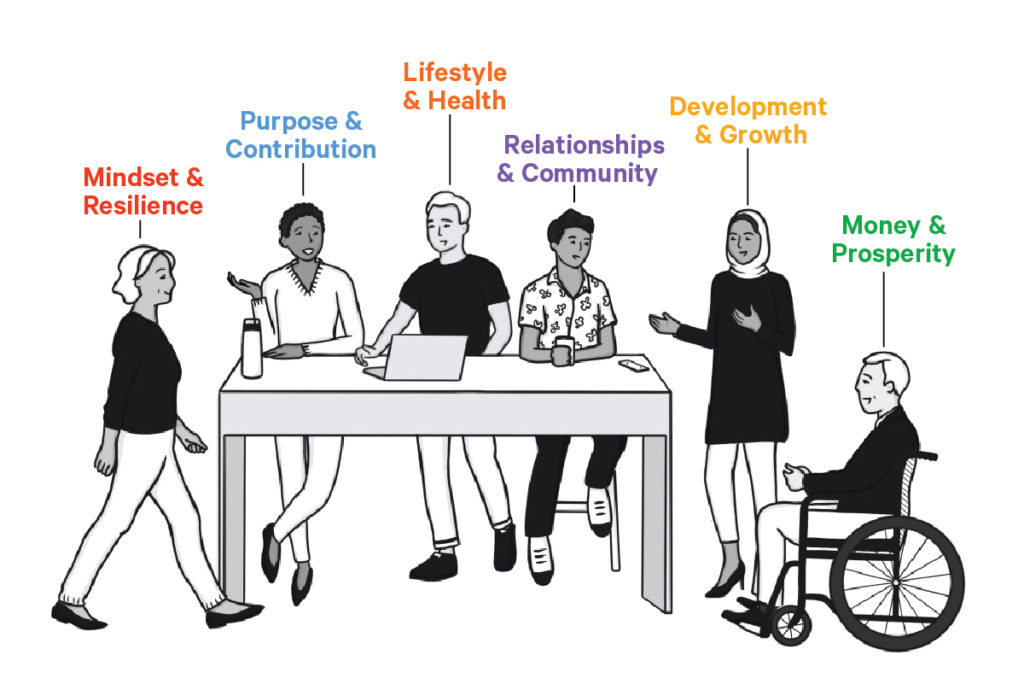The world has seemingly changed over night. Yesterday’s workplace solutions are exactly that — a thing of the past. To build strong workforces, companies will need to think bigger than monetary compensation and consider the needs of the whole person.
What does an employee need to thrive — right now and in the future?
Here’s what the future of workplace well-being looks like in 2020 and beyond.
1. Mental health will take center stage as an individual and organizational priority.
There’s a mental health crisis in America right now. Major depression is on the rise, according to a BlueCross BlueShield study. From 2013 to 2016, the diagnosis of major depression increased by 33 percent. When you look at the breakdown by age group, teens (63 percent) and millennials (47 percent) saw the greatest increases. Americans were also more stressed, angry and worried in 2018 than they have been at most points in the past decade, according to Gallup. That means mental health support will be increasingly important to job applicants both in and entering the workforce. This could include covered services by insurance, as well as virtual care technologies.
And it’s not only important for people with mental illness.
Employees without a mental health condition also benefit greatly from mental health support from their employer. According to the U.S. Department of Health and Human Services, positive mental health allows people to cope with the stresses of life, work more productively and realize their full potential.
There is a need for a broader and deeper support of mental health across the continuum, including for the everyday stressors.”
Carolyn Thayer-Azoff, Aduro’s Senior Director of Mental Health
2. Business leaders will need to further integrate employee well-being into their long-term business strategy — and broaden their definition from “physically healthy” to “holistically healthy.”
Nearly half of all U.S. worksites offer some type of health program to employees, according to the Centers for Disease Control and Prevention. Those programs primarily focus on physical activity, obesity/weight management, and quitting tobacco usage. Unfortunately, traditional wellness programs that focus solely on physical health often fall short of success.
Why?
To see an improvement in employee well-being, you have to consider all of the aspects of someone’s life that influences their ability to flourish. At Aduro, we utilize a science-based approach and expert coaching to deliver a connected experience that supports the whole person across all aspects of life.

By taking an integrated approach, we don’t just narrow in on areas of weakness, we also help employees sharpen their existing strengths. Learn more about the interrelated aspects of life in our Flourishing Summary: a new approach to measuring employee well-being.
For a Human Performance program to be successful, it has to focus on the health of the organizational culture, in addition to the health of the individual. An organization can offer ample resources for employees with mental health struggles, but if the company culture is not authentically supportive of one’s mental health, these resources will only go so far. Likewise, if a holistically healthy employee works at a company with a toxic environment or culture, it’s going to hinder their ability to thrive.
Shifting to a culture of well-being requires continuous, long-term effort. Employers have to be “all in” if they want to see a real, lasting change.
You want to create a well-being system with effective feedback loops. That’s a system that can monitor employee well-being more continuously, deliver real-time actionable feedback — at the individual and population level — and then use the same system to monitor the effectiveness of those actions.”
Renee Petrie, Aduro Chief Product Officer
3. Focus on the necessities of a healthy workplace environment before adding the bells and whistles (like the foosball table).
Sometimes, we get so caught up in the latest trending office perk that we overlook the basics — the physical workplace environment.
A Harvard study validates that employees want you to take care of the basics first:
- Better air quality
- Access to natural light
- The ability to personalize their workspace
Once the foundation is solid, add on some of the “next level” perks, based on what your employees value most.
Googler perks, like EnergyPods for napping, are pretty well-known at this point. But we also love that they invest in their employees’ personal and professional development, from onsite coding to cooking classes or guitar lessons. Other appealing perks include Alliant Credit Union’s paid volunteer day and tuition reimbursement program. Many hospitals are also finding that healing gardens offer benefits to patients — and employees. Aduro promotes a dog-friendly workplace, as dog ownership has been proven to help lower stress — and it’s even been linked to lower blood pressure.
4. Employees need your support to mitigate workplace stress.
Workplace burnout has become so widespread that it’s now classified as an “occupational phenomenon” in the 11th Revision of the International Classification of Diseases (ICD-11).
Although it’s not a medical condition, workplace burnout is included in the chapter that describes the factors that can influence health status or contact with health services.
It’s described as a “… syndrome conceptualized as resulting from chronic workplace stress that has not been successfully managed.”
Since many of us spend more waking hours at work than anyplace else, companies are realizing they have the greatest opportunity for impact. Resilience training (traditionally called “stress management programs”) will continue to gain traction this year, teaching employees about the nature and sources of stress, its effect on their health, and skills they can adopt to help mitigate stress, such as time management or relaxation exercises.
Additionally, employers will continue to experiment with scheduling strategies that may help employees’ well-being at work and at home. This includes flexible schedules (allowing employees to decide when they start and end each day), work-from-home days, and allowing employees to go completely remote that once worked in the office, due to their long commute.
5. Leaders will need to move from a “boss” mentality to a “coach” mentality to help employees grow.
Business consultant and New York Times bestselling author Matthew Kelly talks about “dynamic culture” in his book, “The Culture Solution.” A dynamic culture isn’t something that can be created from the top down. It’s something that every individual has the opportunity to play an active role in creating.
In 2020 and beyond, Matthew Kelly believes that organizations should shift their focus away from office perks that employees don’t necessarily care about and move toward creating a culture that each person feels personally connected to and invested in.
To create a more dynamic culture, organizations will need to rethink how they’ve traditionally approached management. Leaders will need to regularly look for moments of development to help employees reach their full potential. Training, regular feedback, and encouraging employees to pursue growth opportunities are all part of this coach mentality.
As a leader, the best way to help people grow is by making every interaction count through presence, caring, listening, and bringing out the best thinking and behavior in people, which is all part of coaching. Some really simple shifts can make a big difference in the growth, development, and performance of people.”
Dr. Toni Best, Chief Human Performance Officer
Shortening feedback loops from the annual review to quarterly goal setting and performance check-ins, formalizing individual development plans, weekly 1:1s with accountability check-ins, and on-the-spot coaching to bring out the best thinking and decision-making in the individual are all powerful opportunities to enhance individual and company performance, Toni adds.
There couldn’t be a better time to embrace this concept either — as Americans quit their jobs at the highest rate on record in 2019. Two of the main reasons, CNBC reported, were pay and fewer growth opportunities.
Adopting a coach mentality allows managers to support and play an active role in employee growth. Managers can step into this role by identifying patterns, finding ways to interrupt those patterns, and asking powerful questions that elicit new thinking. Listening is also key, as that’s the only way to truly understand what motivates employees to do their best each day. Critical care nurses, for example, might feel empowered to perform their best when their contributions are acknowledged. One study found that meaningful recognition might help to reduce burnout for nurses. Consider making acknowledgement and recognition part of your approach to coaching employees.
6. Tech will continue to be leveraged to make health care more accessible — and create more personalized pathways.
To have powerful Artificial Intelligence (AI), you first need powerful data. Your well-being program should be driven by data that creates tailored experiences for your employees. Data-driven well-being programs also allow for greater flexibility, meeting employees where they are and offering actionable steps forward based on that insight.
In 2020, businesses will also need a comprehensive “listening” strategy that provides opportunities to capture data at the population level.
Digital health services — software and applications collectively known as “digital therapeutics” — will be increasingly utilized to treat diseases and disorders, from asthma and diabetes to depression. Some digital therapeutics are intended to be used in tandem with medication or behavioral interventions, the American Psychological Association reported, while others aim to replace traditional treatment completely.
Telehealth also puts health information and support at employees’ fingertips. It entails using digital information and communication technologies (such as computers or mobile devices) to access health-care services remotely and manage health-care services.
Natural Language Processing (NLP) further strengthens the power of digital therapeutics and telehealth technology by analyzing the written and spoken word. NLP can passively detect signals, ensuring the person is kept in the forefront (versus the technology), and further personalize the experience.
By integrating these employee well-being trends into your business strategy, you’ll be helping to attract, retain and grow top performers.
Prevent employee burnout
At Aduro, we believe in “active resilience.” It’s the notion that you can’t work on resilience for six weeks and think you’re good to go—building resilience is a process, and strengthening it is like working a muscle. You have to use it regularly, in all areas of life. Because it impacts all areas of life. Learn more in our resilience white paper.

